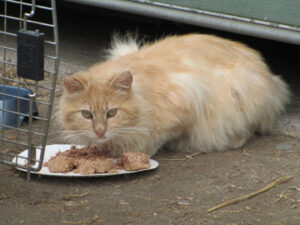For healthy community cats in need of TNR



Low-cost spay/neuter:
Facebook links for trapping assistance and spay/neuter:
For assistance with transport of live-trapped cats for TNR or colony relocation:
IMPORTANT WHEN REPORTING A CAT IN NEED OF RESCUE: include your location (address/city), number of cats (approximate), ages/genders of cats (if known), physical descriptions (health) and any photos when requesting help on these pages. Field rescuers can assist with Trap-Neuter-Return (TNR) and urgent situations.
Contact outreach@felinerescue.org for a live trap or heated water dish loan for outdoor cats and colonies. There is a sign-out folder in the entryway at Feline Rescue. Bowls and traps must be returned clean and empty.
We also offer winter cooler shelters for cats free of charge. MNSNAP and the AHS also have live traps available for short-term loan use.
Healthy community cats
A healthy community cat can be socialized or unsocialized to humans. However, it is adept at finding food and shelter and has no need to be indoors. The cat may or may not be able to be handled (depending upon age) or approached. It will generally have a well-groomed appearance. It may be visible day or night.
Please have the cat checked for a microchip: any vet will do this for free. If the cat has a microchip, then you must phone and email its owner. If the owner doesn’t respond, then bring the cat to animal control. If animal control won’t take the cat, then apply for intake at an area rescue. (See Rescues and Resources list above).
If the cat is not ear-tipped to indicate Trap-Neuter-Return (TNR), it is likely in need of TNR. Please make a Community Cat appointment at the Animal Humane Society. Note: hissing is a fear response and growling is a warning; both are possible with stray or feral cats.
If this does not address your situation and you require further assistance, please send an email to outreach@felinerescue.org or leave a message: (651) 760-8739
DO NOT live trap a healthy community cat unless these resources are in place:
1. A safe, temperature-comfortable place for the cat to go immediately after capture.
2. The ability to monitor the live trap around the clock and check it personally every hour (15 minutes in extreme weather); live-feed cameras are highly encouraged.
3. A lightweight, waterproof tarp to protect the trap from rain/snow or a cotton sheet for sun protection until the cat can be relocated to a sheltered holding area.
4. A food and water bowl inside the trap. Wee pads or an old towel under the trap. Use a tarp and towels under the trap inside a vehicle during transport. Cover the trap with a sheet to help keep the cat calm during transport.
5. A secured TNR appointment for the cat (spay/neuter/return) within a day or two of trapping.
6. A plan for checking the cat for a microchip (if the cat is socialized) at any local vet for free if the owner has not been located.
7. The resources to care for the cat properly: dry cat food, fresh water and a litter box for a socialized stray in a home and wee pads for an unsocialized cat in a trap until transfer.
8. A safe space for the cat overnight after surgery, with food and water. A cat can be injured or predated if released while still under the effects of anesthesia.
A spare bathroom or garage can work for temporarily holding a cat. Be aware of the physical possibility of fleas, worms, ear mites and vomiting or diarrhea.
Take precautions by using bite-proof Kevlar gloves/sleeves and/or heavy duty gloves if handling an unknown cat, especially if it is showing signs of fear or aggression. Always choose to patiently cajole the cat into a carrier or trap with bait; grabbing a cat is the last resort. Remember this rule: control the neck, control the cat. Hold the cat carefully but firmly behind the neck and quickly wrap in a towel if direct transfer out of a trapped space is needed.
NOTE: It is highly stressful for a cat to be forcefully kenneled and can often result in dangerous bites and scratches. Think like a cat to catch a cat and work with compassion.
IMPORTANT NOTES:
1. Be aware of the possibility of nursing kittens with a trapped female cat. Look for signs of lactation/swollen mammaries and return her immediately to the general area to look/listen for the kittens. Kittens cannot go without nursing for long periods of time under the age of 6 weeks. Release the cat if needed and re-trap the mother after the kittens are 6 weeks old. Kittens can still nurse after spay surgery, if needed. Take care to hold the mother overnight until surgery anesthesia has worn off, and offer wet food for the kittens.
2. Rescues and shelters do NOT intake unsocialized cats or healthy community cats. If you bring a cat to a shelter that is not specifically no-kill and it shows aggression, it may likely be euthanized. It is better to return an undetermined or unsocialized cat to its neighborhood or location of origin once it is spayed/neutered. The alternative to this is a sanctuary, which can be found on the bottom of this Resources list.
3. Tip for baiting a live trap: add rotisserie chicken into a small dish; slide it carefully into the back of the trap. Sprinkle Silvervine powder leading into the trap toward the food. Silvervine can be found online; it is similar to cat nip in effect but is more powerful. Set the trap and drape a light sheet over the back half of the trap or use a lightweight tarp if there is inclement weather. Monitor the trap via live feed camera or checking every 15 minutes for as long as the trap is open.
Trap training: for at least 1-3 days prior to trapping, tie open the trap door with a strong string and feed the cat inside the back of the trap. This is will allow the cat to get familiar with the trap without it closing. On the evening of trapping, place a lightweight or waterproof drape over the back half of the trap, untie the string, bait with Rotisserie chicken and Silvervine powder leading into the trap, and set the trap. Monitor the trap with a live camera and/or check the trap every 15 minutes (especially critical in cold or wet weather.) Once the cat is trapped for transport, move the trap to a protected area and provide fresh water in the food bait dish using a squeeze water bottle. If holding the cat for longer than 24-48 hours, it is ideal to have a kennel holding space for the cat to reside in, with a litter box and food/water dishes, until re-trap for a TNR appointment transport.
How to set a Havahart trap: https://youtu.be/yrbWPrwHmr8
How to set a TruCatch trap: https://youtu.be/4h59lYVCsig
Additional TNR and live trapping information from Alley Cat Allies:
PROPERTY OWNERS: If you have available space and are willing to provide food, fresh water and comfortable shelter for TNR community cats, please post that resource on this Facebook relocation page. Thank you!
Phone: 612-900-2757
Email: info@FelineRescue.org
St. Paul, MN 55104
